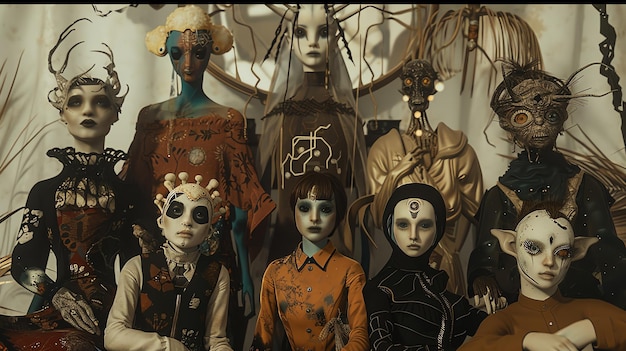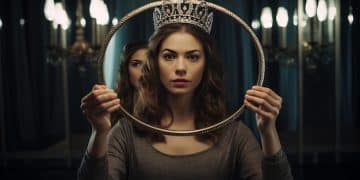The Evolution of Villainy in US Dramas: A Comparative Review

The Evolution of Villainy: A Comparative Review of Antagonists in Recent US-Dubbed Dramas explores how villain archetypes have transformed, focusing on complexity, motivations, and impact on narratives in popular shows.
Villains have always been integral to dramatic storytelling, and recent US-dubbed dramas offer a fascinating perspective on the evolving nature of these characters. Join us as we delve into The Evolution of Villainy: A Comparative Review of Antagonists in Recent US-Dubbed Dramas, exploring how these characters have become more nuanced, complex, and integral to the narratives they inhabit.
The Shifting Sands of Villain Archetypes
Traditional villain archetypes, such as the mustache-twirling evildoer or the power-hungry tyrant, are increasingly giving way to more complex and morally ambiguous characters. This shift reflects a broader trend in storytelling towards exploring the shades of gray between good and evil.
Modern villains often possess relatable motivations or tragic backstories that humanize them, making it difficult for audiences to simply dismiss them as “bad guys.” Instead, viewers are invited to understand their perspectives, even if they don’t condone their actions.
From Caricature to Complexity
Early depictions of villains often relied on exaggerated traits and simplistic motivations. However, contemporary dramas are embracing complexity, delving into the psychological depths of their antagonists.
This evolution allows for richer storytelling, as the conflict between protagonist and antagonist becomes more than just a battle of good versus evil. It becomes a clash of ideologies, motivations, and perspectives.
- Nuanced Motivations: Modern villains have understandable (though not always justifiable) reasons for their actions.
- Moral Ambiguity: They often operate in gray areas, blurring the lines between right and wrong.
- Relatable Flaws: Villains now possess vulnerabilities and flaws that make them more human.
- Complex Backstories: Their past experiences often shape their present-day villainy.
The move away from simplistic villainy allows writers to explore deeper themes such as morality, justice, and the human condition, enriching the narrative experience for viewers. This complexity ensures that the antagonists are not just obstacles for the heroes but compelling characters in their own right.
Motivations Beyond Pure Evil
One of the key aspects of the evolution of villainy is the shift in motivations. Whereas older villains were often driven by a lust for power or a desire to cause chaos, modern antagonists are driven by more relatable, human desires.
These motivations can range from a desire to protect their family to a belief that they are acting for the greater good, even if their methods are questionable.

The Justification of Villainy
Many modern villains perceive themselves as the heroes of their own stories, justifying their actions through a distorted moral code or a belief in a greater purpose.
This self-justification often leads to a fascinating exploration of perspective, as viewers are forced to consider the antagonist’s point of view, even if they disagree with their methods.
- Protecting Loved Ones: Actions are justified as necessary to safeguard family or friends.
- Belief in the Greater Good: Villains act believing they are ultimately benefiting society.
- Revenge: Driven by past injustices and seeking retribution.
- Ideological Extremism: Commitment to radical beliefs that justify extreme measures.
By moving beyond simplistic depictions of evil, writers can present more compelling narratives that challenge viewers to question their own moral compass and consider the complexities of human behavior. This depth adds layers to the storyline, making it more intriguing and thought-provoking.
The Impact of US Dubbing on Villain Portrayals
The dubbing process in US dramas can significantly impact how villainous characters are perceived. Nuances in performance, dialogue, and cultural context can be either amplified or lost in translation.
This can lead to a reinterpretation of the villain’s motivations and overall characterization, potentially altering the audience’s emotional response.
Voice Acting and Interpretation
Voice actors play a crucial role in shaping the audience’s perception of a villainous character. The tone, inflection, and emotional range of the voice can significantly alter the character’s portrayal.
A well-dubbed performance can enhance the villain’s complexity, while a poorly dubbed one can flatten their character and reduce them to a caricature.
- Emotional Range: Voice actors can add depth through vocal nuances.
- Cultural Context: Dubbing needs to respect and convey original cultural nuances.
- Authenticity: Maintaining the integrity of the original performance is key.
- Subtlety in Delivery: Adds layers to the villain’s persona.
The subtleties and nuances imbued by voice actors can elevate the performance, providing greater depth and dimension to the antagonist. This ensures that the dubbed version retains the complexity and richness intended by the original creators, offering a more engaging viewing experience.
Moral Ambiguity as a Narrative Tool
Moral ambiguity has become a powerful narrative tool in contemporary dramas. By presenting villains who are not purely evil, writers can create more complex and engaging storylines.
This approach encourages viewers to question their own morality and consider the complexities of human behavior, leading to more thought-provoking and impactful viewing experiences.
Challenging Audience Expectations
Morally ambiguous villains challenge the traditional good versus evil dichotomy, forcing viewers to confront uncomfortable truths and question their own assumptions.
This subversion of expectations can lead to more surprising and unpredictable narratives, keeping audiences engaged and invested in the story.
- Blurred Lines: Audiences question easy distinctions between good and evil.
- Complex Decisions: Characters face difficult choices with no clear right answer.
- Deeper Engagement: Viewers become more invested in the characters’ journeys.
- Ethical Dilemmas: Stories explore challenging ethical issues.
By challenging viewers’ expectations, shows can provoke meaningful discussions and encourage people to think critically about the complexities of ethical decision-making. This approach elevates the viewing experience, making it both entertaining and intellectually stimulating.
Examples of Compelling Villains in Recent US-Dubbed Dramas
Several recent US-dubbed dramas have featured particularly compelling and well-developed villains. These characters exemplify the evolution of villainy, showcasing complexity, nuance, and relatable motivations.
These examples demonstrate the impact that a well-crafted villain can have on a narrative, elevating the story and challenging viewers to think critically about morality and human behavior.

Case Studies in Villainy
Examining specific examples from recent US-dubbed dramas provides insight into the diverse ways in which villains are being portrayed and the impact they have on storytelling.
These case studies reveal the many facets of villainy, from the manipulative mastermind to the tragic figure driven by circumstance.
- The Ruthless Corporate Executive: Driven by power and wealth, but also reveals moments of vulnerability.
- The Charismatic Cult Leader: Manipulates followers with charm and ideological fervor.
- The Vigilante with Good Intentions: Takes justice into their own hands, blurring moral lines.
- The Corrupt Politician: Driven by ambition but also shows a desire to help constituents.
By considering these different examples, viewers can gain a deeper understanding of how contemporary dramas are redefining the role of the villain, making them more than just antagonists but integral components of compelling narratives.
The Future of Villainy in US Dramas
The evolution of villainy in US dramas is likely to continue, with writers pushing the boundaries of character development and exploring even more complex and morally ambiguous antagonists.
This ongoing evolution promises to deliver even more engaging and thought-provoking storylines that challenge viewers to question their own morality and consider the complexities of human behavior.
Trends to Watch
Anticipating future trends in villain portrayals can offer insights into the evolving nature of storytelling and the ways in which dramas reflect and shape societal values.
By tracking these trends, viewers can better understand the complex relationship between villains, narratives, and the audiences who consume them.
- Greater Psychological Depth: Further exploration of mental health and trauma.
- Villains as Protagonists: Shifting perspectives to focus on the antagonist’s journey.
- Deconstruction of Traditional Archetypes: Subverting established villain tropes.
- Emphasis on Systemic Issues: Villains embodying societal flaws and injustices.
As dramas continue to explore these avenues, the role of the villain will evolve, pushing the boundaries of storytelling and encouraging viewers to think critically about the world around them. This innovative approach will keep audiences engaged and entertained for years to come.
| Key Point | Brief Description |
|---|---|
| 🎭 Shifting Archetypes | Villains evolve from simple to complex characters. |
| 🤔 Motivations | Motivations move beyond pure evil to relatable desires. |
| 🎤 US Dubbing | US dubbing significantly impacts villain portrayal. |
| ⚖️ Moral Ambiguity | Moral ambiguity is now a powerful narrative tool. |
FAQ
▼
Villain archetypes have shifted from simple evildoers to complex characters with understandable motivations. They often exhibit moral ambiguity and relatable flaws, blurring the lines between good and evil.
▼
Common motivations include protecting loved ones, believing they are acting for the greater good, seeking revenge for past injustices, and ideological extremism. These motivations add depth and complexity to their character.
▼
US dubbing can significantly impact how villains are perceived, as voice actors’ interpretation and emotional range can either enhance or flatten their character, altering the audience’s emotional response.
▼
Moral ambiguity is a powerful tool that challenges traditional dichotomies, forcing viewers to confront truths and assumptions. It leads to surprising narratives and deeper engagement with ethical issues, enhancing the viewing experience.
▼
Future trends may include greater psychological depth, villains as protagonists, deconstruction of traditional archetypes, and emphasis on systemic issues. These trends promise more engaging and critically challenging storylines in US dramas.
Conclusion
The evolution of villainy in US-dubbed dramas reflects a broader trend in storytelling towards complexity, nuance, and moral ambiguity. By exploring the motivations and psychological depths of their antagonists, writers are creating more compelling and thought-provoking narratives that challenge viewers to question their own assumptions and consider the complexities of human behavior.





